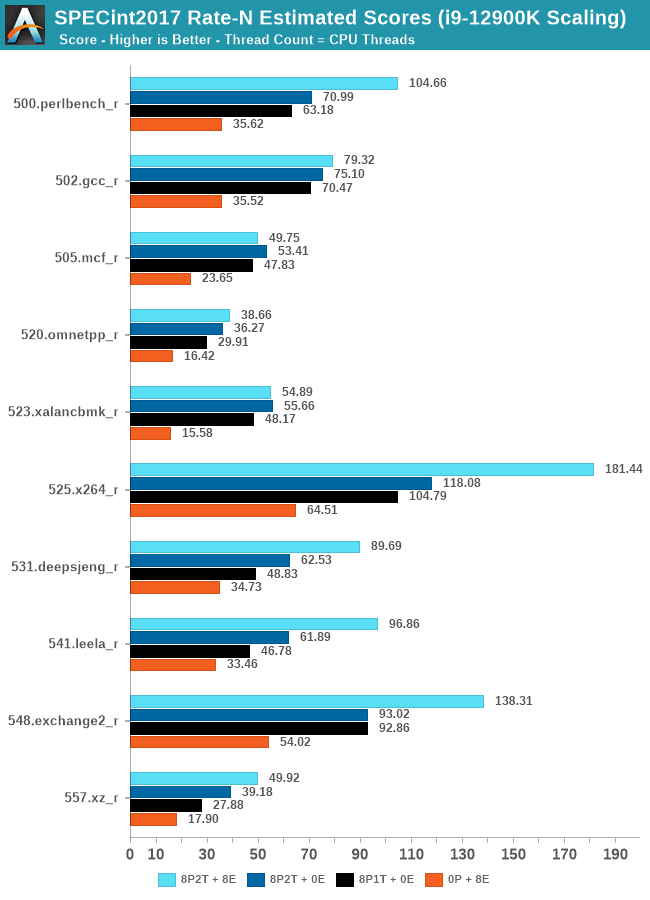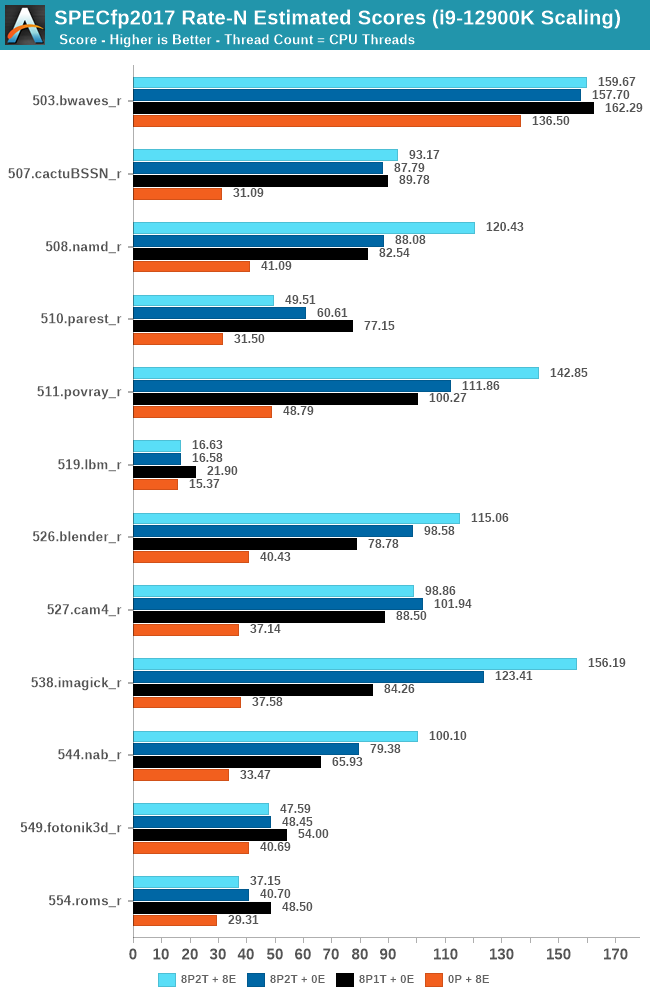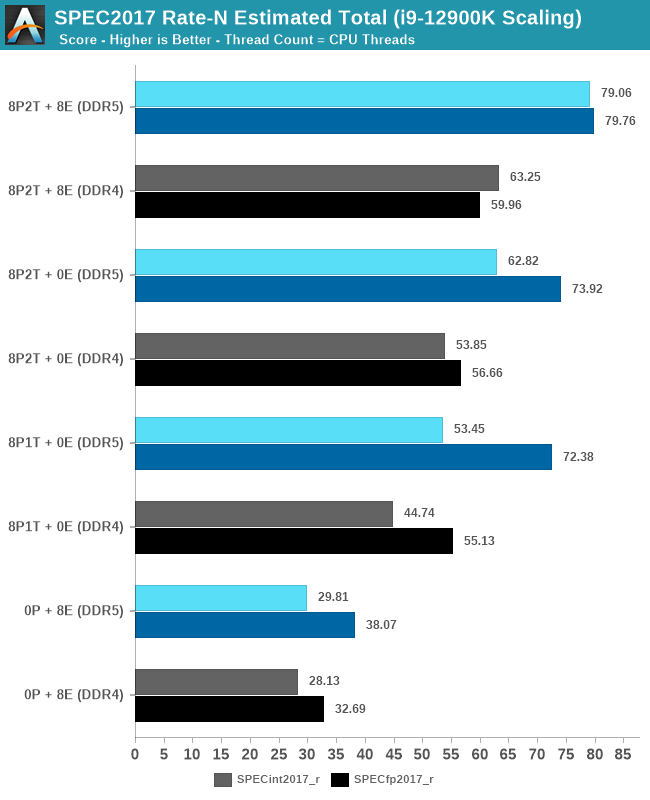The Intel 12th Gen Core i9-12900K Review: Hybrid Performance Brings Hybrid Complexity
by Dr. Ian Cutress & Andrei Frumusanu on November 4, 2021 9:00 AM ESTCPU Tests: SPEC MT Performance - P and E-Core Scaling
Update Nov 6th:
We’ve finished our MT breakdown for the platform, investigating the various combination of cores and memory configurations for Alder Lake and the i9-12900K. We're posting the detailed scores for the DDR5 results, following up the aggregate results for DDR4 as well.
The results here solely cover the i9-12900K and various combinations of MT performance, such as 8 E-cores, 8 P-cores with 1T as well as 2T, and the full 24T 8P2T+8E scenario. The results here were done on Linux due to easier way to set affinities to the various cores, and they’re not completely comparable to the WSL results on the previous page, however should be within small margins of error for most tests.

In the integer suite, the E-cores are quite powerful, reaching scores of around 50% of the 8P2T results, or more.
Many of the more core-bound workloads appear to very much enjoy just having more cores added to the suite, and these are also the workloads that have the largest gains in terms of gaining performance when we add 8 E-cores on top of the 8P2T results.
Workloads that are more cache-heavy, or rely on memory bandwidth, both shared resources on the chip, don’t scale too well at the top-end of things when adding the 8 E-cores. Most surprising to me was the 502.gcc_r result which barely saw any improvement with the added 8 E-cores.
More memory-bound workloads such as 520.omnetpp or 505.mcf are not surprising to see them not scale with the added E-cores – mcf even seeing a performance regression as the added cores mean more memory contention on the L3 and memory controllers.

In the FP suite, the E-cores more clearly showcase a lower % of performance relative to the P-cores, and this makes sense given their design. Only few more compute-bound tests, such as 508.namd, 511.povray, or 538.imagick see larger contributions of the E-cores when they’re added in on top of the P-cores.
The FP suite also has a lot more memory-hungry workload. When it comes to DRAM bandwidth, having either E-cores or P-cores doesn’t matter much for the workload, as it’s the memory which is bottlenecked. Here, the E-cores are able to achieve extremely large performance figures compared to the P-cores. 503.bwaves and 519.lbm for example are pure DRAM bandwidth limited, and using the E-cores in MT scenarios allows for similar performance to the P-cores, however at only 35-40W package power, versus 110-125W for the P-cores result set.
Some of these workloads also see regressions in performance when adding in more cores or threads, as it just means more memory traffic contention on the chip, such as seen in the 8P2T+8E, 8P2T regressions over the 8P1T results.

What’s most interesting here is the scaling of performance and the attribution between the P-cores and the E-cores. Focusing on the DDR5 set, the 8 E-cores are able to provide around 52-55% of the performance of 8 P-cores without SMT, and 47-51% of the P-cores with SMT. At first glance this could be argued that the 8P+8E setup can be somewhat similar to a 12P setup in MT performance, however the combined performance of both clusters only raises the MT scores by respectively 25% in the integer suite, and 5% in the FP suite, as we are hitting near package power limits with just 8P2T, and there’s diminishing returns on performance given the shared L3. What the E-cores do seem to allow the system is to allows to reduce every-day average power usage and increase the efficiency of the socket, as less P-cores need to be active at any one time.










474 Comments
View All Comments
ButIDontWantAUsername - Wednesday, November 10, 2021 - link
How's that validation with Denuvo going? Nothing like upgrading to Intel and having your games suddenly start crashing.Iketh - Tuesday, November 30, 2021 - link
please, no more comments from youtuxRoller - Friday, November 5, 2021 - link
Most desktops at enterprise companies could be replaced with terminals given that most of the people are really just performing data entry & retrieval. The network is the bit doing the work.For people who need old school workstations, then I agree, but that's a damn small (but high margin) market.
blanarahul - Thursday, November 4, 2021 - link
Alder Lake is extremely efficient when gaming - https://www.igorslab.de/en/intel-core-i9-12900kf-c...Scroll down and you'll find a graph detailing total gaming power consumption (CPU + GPU) and CPU power consumed per fps. In both metrics, Alder Lake is doing better than Zen 3 and much better than Rocket Lake.
PC World's review - https://www.pcworld.com/article/548999/12th-gen-co... - conveys that while 12900K goes volcanic in Cinebench, it sips power in a real world workload.
It seems like Alder Lake for desktop has been clocked way beyond its performance/watt sweet spot. It should be very interesting to compare Alder Lake for laptops v/s Zen 3 for laptops.
blanarahul - Thursday, November 4, 2021 - link
To give a short summary for (only) CPU power consumption v/s FPS when playing Horizon Zero Dawn11900K consumes 100 watts for 143 fps
5950X consumes 95 watts for 145 fps
5800X consumes 59 watts for 144 fps
12900K consumes 52 watts for 146 fps
12700K consume 43 (!) watts for 145 fps
Intel is very, very competent with AMD. Considering that 12700K has less E cores and consumes less power, I am very curious how it would do with all E cores disabled and running only on P cores.
Netmsm - Thursday, November 4, 2021 - link
Sounds like there is only gaming world!In PCs it may not be considered as a egregious blunder however you're right Intel is now competitive but to previous AMD's if and only if we wink at Intel's guzzling power.
Some examples from Tom's benches:
y-cruncher
12900k DDR5 consumes 197 watts whereas 5950x consumes 103 watts.
handbrake
12900k DDR5 consumes 224 watts whereas 5950x consumes 124 watts.
blender bmw27
12900k DDR5 consumes 205 watts whereas 5950x consumes 125 watts.
Will you calculate power efficiency, please?
geoxile - Thursday, November 4, 2021 - link
My 5950X uses 130-140W in y-cruncher. And @TweakPC on twitter tested lower PL1 and found the 12900k was only around 5% slower using 150W than 218W. Alderlake being power hungry is only because Intel is pushing 8 P-cores and 8 E-cores (collectively equal to around 4 P-cores according to Intel) to the limit, to compete against 16 Zen 3 cores. You can argue that it's still not as good as the 5950X but efficiency in this case is purely a problem of how much power Intel is allowing by defaultflyingpants265 - Thursday, November 4, 2021 - link
Because they need all that extra power to increase their performance a tiny bit. They're not just doing it for fun.Netmsm - Saturday, November 6, 2021 - link
Exactly 👍Netmsm - Thursday, November 4, 2021 - link
Even Ian has "accidentally" forgotten to put nominal TDP for 12900k in results =))All CPUs in "CUP Benchmark Performance: Intel vs AMD" are mentioned with their nominal TDP except 12900k.
It sounds there's some recommendations! How venal!